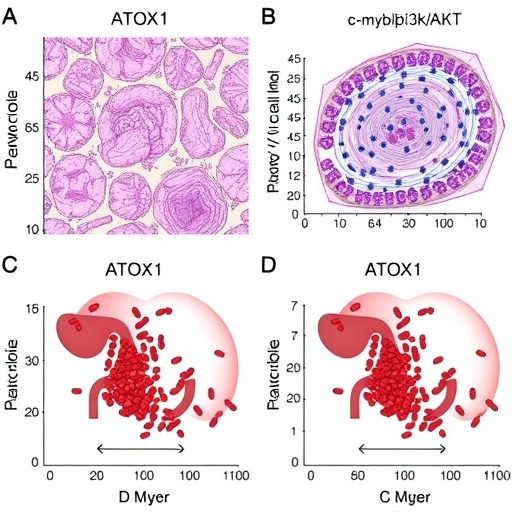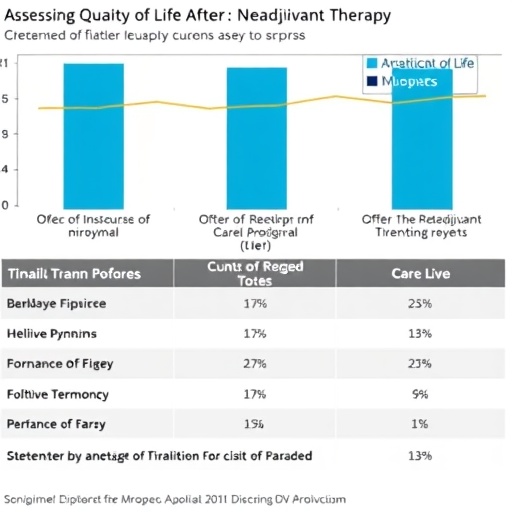
In the relentless pursuit to unravel the molecular intricacies underlying hepatocellular carcinoma (HCC), a recent breakthrough has illuminated the pivotal role of Antioxidant-1 (ATOX1) in promoting tumorigenesis. This discovery, published in the esteemed Journal of Clinical and Translational Hepatology, reveals how ATOX1 facilitates carcinogenesis through complex interactions within the c-Myb/PI3K/AKT signaling axis, presenting new horizons for targeted therapeutic interventions in liver cancer.
Hepatocellular carcinoma remains a formidable global health challenge, characterized by high morbidity and mortality despite significant advances in diagnosis and treatment. The pursuit of molecular drivers that orchestrate the aggressive phenotype of HCC is crucial for innovating more effective therapies. ATOX1, traditionally recognized as a copper chaperone involved in intracellular metal homeostasis, has emerged as a multifaceted protein influencing oncogenic pathways. However, its precise role in HCC pathophysiology has hitherto been poorly understood.
Comprehensive immunohistochemical analyses affirm that ATOX1 is markedly overexpressed in HCC tumor tissues compared to normal hepatic counterparts. This aberrant elevation correlates strongly with enhanced malignant behaviors such as increased cellular proliferation, colony-forming capacity, and migratory potential. Experimental knockdown of ATOX1 in HCC cell lines leads to significant suppression of tumor growth in vivo, underscoring its indispensable function in tumor maintenance and progression.
.adsslot_8Qg5hnBEYJ{width:728px !important;height:90px !important;}
@media(max-width:1199px){ .adsslot_8Qg5hnBEYJ{width:468px !important;height:60px !important;}
}
@media(max-width:767px){ .adsslot_8Qg5hnBEYJ{width:320px !important;height:50px !important;}
}
ADVERTISEMENT
Mechanistic interrogation through RNA sequencing uncovers that ATOX1 exerts its oncogenic influence predominantly by activating the transcription factor c-Myb. This activation propagates downstream signaling via the PI3K/AKT pathway, a well-documented promoter of cell survival, proliferation, and metabolic reprogramming in cancer. The ATOX1-driven c-Myb/PI3K/AKT cascade thus establishes a feed-forward loop amplifying the malignant phenotype in hepatic tumor cells.
Intriguingly, ATOX1 not only modulates proliferative signaling but also intricately regulates intracellular copper levels. It appears to facilitate copper efflux or sequestration that prevents copper accumulation within tumor cells, thereby attenuating copper-induced oxidative stress. This copper regulation results in diminished reactive oxygen species (ROS) production, effectively reducing cellular apoptosis and allowing cancer cells to evade programmed cell death.
Pharmacological inhibition of ATOX1’s copper transfer function using the small molecule DCAC50 manifests as a promising therapeutic strategy. Treatment with DCAC50 elevates intracellular copper concentrations, increases ROS generation, and triggers apoptotic pathways, culminating in the suppression of HCC cell proliferation. This compound exquisitely exemplifies how targeting metal homeostasis can influence cancer cell viability and underscores the therapeutic potential of copper modulation in oncology.
The study also reveals a redox-sensitive modulatory mechanism where antioxidant treatment with acetylcysteine reverses the decrease in c-Myb expression caused by ATOX1 knockdown. This finding highlights the nuanced interplay between oxidative stress and oncogenic signaling networks, suggesting that the tumor microenvironment’s redox state can critically influence cancer progression via ATOX1 activity.
These multifaceted functions of ATOX1 position it as a central molecular node linking copper metabolism, redox balance, and oncogenic signaling in HCC. Targeting ATOX1, therefore, offers a dual advantage: disrupting the c-Myb/PI3K/AKT proliferative axis and sensitizing tumor cells to oxidative stress-mediated apoptosis. Such a combinatorial therapeutic approach could markedly improve the efficacy of current treatment regimens.
From a translational perspective, the inhibition of ATOX1, especially through compounds like DCAC50, paves the way for novel interventions that can synergize with existing PI3K/AKT inhibitors. This strategy might overcome resistance mechanisms and achieve more durable responses in patients with advanced HCC, a malignancy often refractory to conventional therapies.
Moreover, the elucidation of copper’s role in modulating oxidative stress and signaling pathways via ATOX1 expands the broader understanding of metal biology in cancer. It invites a paradigm shift wherein metalloproteins are appreciated not only as passive facilitators of cellular metabolism but as dynamic regulators of oncogenic networks and potential vulnerabilities exploitable for therapy.
This groundbreaking research underscores the necessity for continued investigation into the molecular underpinnings of HCC and highlights the importance of integrating biochemical, genetic, and pharmacological insights to design targeted cancer therapies. ATOX1 arises from this study not merely as a biomarker of disease aggressiveness but as a tangible target with significant clinical promise.
In sum, the discovery of ATOX1’s role in driving hepatocellular carcinoma through activation of the c-Myb/PI3K/AKT pathway, coupled with its regulation of copper homeostasis and oxidative stress, offers a compelling narrative that merges fundamental cancer biology with innovative therapeutic strategies. As the field advances, targeting ATOX1 may well become a cornerstone in combating liver cancer and improving patient outcomes worldwide.
Subject of Research: Hepatocellular carcinoma (HCC) mechanisms focusing on the role of Antioxidant-1 (ATOX1) in tumor progression via molecular signaling pathways.
Article Title: ATOX1 Promotes Hepatocellular Carcinoma Carcinogenesis via Activation of the c-Myb/PI3K/AKT Signaling Pathway
News Publication Date: 7-Jul-2025
Web References:
https://www.xiahepublishing.com/journal/jcth
http://dx.doi.org/10.14218/JCTH.2024.00422
Image Credits: Jian Huang, Donghu Zhou
Keywords: Hepatocellular carcinoma, Reactive oxygen species, ATOX1, c-Myb, PI3K/AKT signaling, copper metabolism, apoptosis, DCAC50, oxidative stress
Tags: ATOX1 knockdown effects on tumor growthATOX1 overexpression in HCCATOX1 role in hepatocellular carcinomac-Myb PI3K AKT signaling pathwaycopper chaperone in cancerHCC cellular proliferation and migrationhepatocellular carcinoma tumorigenesisimmunohistochemical analysis of liver tumorsliver cancer molecular driversliver cancer research advancementsoncogenic pathways in hepatocellular carcinomatargeted therapies for liver cancer





